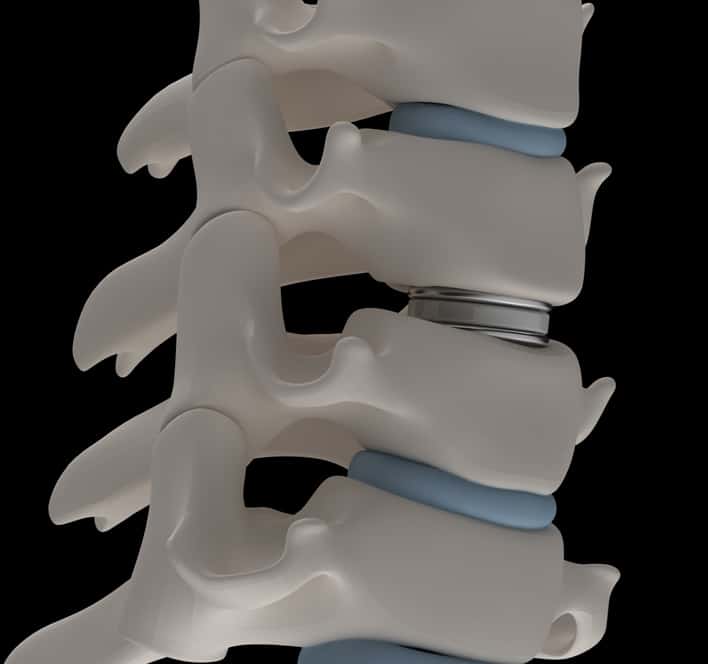Cervical artificial disc replacement (ADR) surgery involves removing a damaged or herniated disc in the neck region and replacing it with an artificial disc. It is also known as cervical disc arthroplasty. The diseased cervical disc is replaced by an artificial mechanical disc, commonly made from medical-grade metal like titanium, plastic, or a combination of both. ADR surgery mimics the idea of a ball-and-socket joint apparatus.
Cervical artificial disc replacement surgery is relatively safe, but it has a risk window like any other surgery. You deserve the best possible treatment if you are considering getting an ADR procedure. Reach out to NJ Spine & Orthopedic’s patient care advocates and spinal specialists. We are dedicated to understanding our patients’ unique needs so we can support them before, during, and after surgery to ensure the best possible results.
Under What Circumstances Is a Cervical Disc Replacement Surgery Performed?
Cervical artificial disc replacement surgery is only recommended where your symptoms do not respond to non-surgical treatment options. ADR surgery may be performed under the following circumstances:
- To relieve pressure on the spinal cord or nerves caused by the damaged intervertebral disc and to restore normal mobility and function of the neck.
- To remove a damaged cervical intervertebral disc that has herniated and compresses the nerve roots that travel to the upper extremities.
Cervical disc degeneration often presents with several common symptoms, including pain radiating down the shoulders or arms, headaches, weakness in the arms or legs, arm numbness, neck pain, and neck stiffness. If left untreated, these symptoms may worsen.
Symptoms of a Failed Cervical ADR Surgery
Cervical artificial disc replacement surgery is intended to address spinal conditions while preserving natural spinal mobility. However, maintaining spinal motion in a degenerative segment may allow continued degeneration of the spinal segment, leading to conditions such as spinal stenosis, degenerative disc disease, and facet arthropathy.
In some cases, the surgery, although quite straightforward, may fail. If cervical artificial disc replacement surgery fails, symptoms such as pain, weakness, or numbness may persist or worsen. These symptoms may indicate the need for further medical evaluation and potential revision surgery.
Some possible symptoms of a failed cervical artificial disc replacement surgery may include:
- Artificial disc migration: In some cases, the disc implant moves with time if the device’s hardware fails or its attachment to the bone loosens.
- Pain: Some patients do not experience pain relief, even if the surgery was successful.
- Adverse reaction to metal: There are isolated reported cases of artificial discs with metal-on-metal bearings that produce off metal ions, which may react with tissues to cause pain or eventual implant failure.
- Paralysis: Although extremely rare, surgical mistakes could lead to injury of the spinal cord or a nerve root, which could result in paralysis in one or more limbs.
If you are experiencing any of the above-listed symptoms after undergoing an ADR surgery, chances are the surgery failed. You should therefore contact your surgeon immediately for guidance on what to do next.
What Treatment Options Do You Have For a Failed Cervical Disc Replacement Surgery?
If cervical disc replacement surgery is unsuccessful, it isn’t the end of the road. Various treatment options may be available to you, including:
1. Anterior Revision
This involves removing the artificial disc from the patient’s neck through an incision made in the front of the neck. Following the removal of the artificial disc, the surgeon will perform decompression and fusion, which involves removing any damaged tissue and fusing the adjacent vertebrae together using a bone graft or other implant.
This action removes all motion, preventing further degeneration in that region. It helps to provide stability to the spine and alleviate symptoms associated with spinal conditions such as spinal stenosis or degenerative disc disease.
2. Posterior Fusion
Although this is an alternative treatment plan, it does not involve removing the artificial disc. Therefore, it may not address recurrent stenosis that leads to spinal cord compression or nerve roots.
Schedule a Consultation With NJ Spine & Orthopedic
If you or a family member suffers from a health condition related to the spine, NJ Spine & Orthopedic is here to provide you with the most advanced treatment options. We have ample experience employing a wide range of treatment methods to help our patients achieve a pain-free lifestyle by considering their needs to determine the best treatment options. Our spine surgeons are dedicated to using advanced minimally-invasive procedures and providing a safe and comfortable environment for our patients to help them get on the path to recovery. Our Concierge Team can also help you plan every aspect of your appointments to take any added stress off your shoulders.
You can schedule a complimentary consultation by contacting our office today at (866) 553-0612 or filling out our contact form. Let us help you today!

